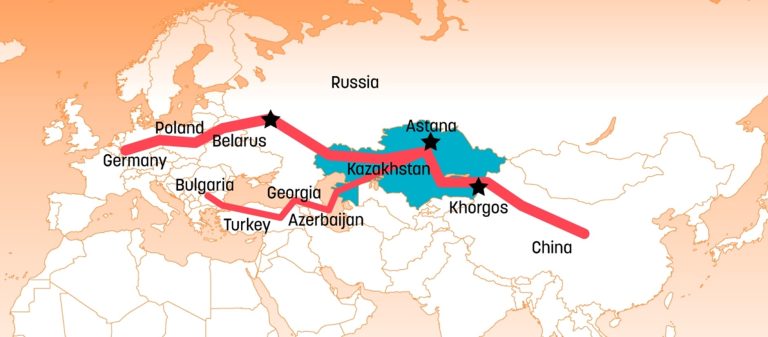Press Releases
- Article
Will Kazakhstan Revitalize the Bottlenecked Asia-Europe Trade Route Through the Middle Corridor?
August 19, 2022
Kazakhstan, the strategic linchpin country in Central Asia, recently accentuated its plan to make the Trans-Caspian route a priority for the country’s oil exports. Located in a region rich in natural resources and crucial for trade and commerce between Europe and Asia, Kazakhstan has drawn the roadmap to build and safeguard uninterrupted international transit traffic. “The Trans-Caspian route meets the security requirements for the supplies and the demand for transcontinental cargo delivery,” said Kazakh Prime Minister Alikhan Smailov at Boao Forum for Asia 2022.

The Trans-Caspian International Transport Route, widely called the “Middle Corridor”, is a multilateral institutional development linking China’s rail freight transport networks and the EU through Central Asia, the Caucasus, Turkey, and Eastern Europe. Since the war in Ukraine commenced this spring, which retarded trade going through the “Northern Corridor” (China, Kazakhstan, Russia, Belarus, Poland, Germany), investing in the “Middle Corridor” has become more relevant and appealing. “Following the results of five months this year, the volume of transportation of Kazakhstan’s cargoes along the route increased 2.5 times, and the total cargo turnover with the Caspian countries increased by more than nine percent,” highlighted Kazakh President Kassym-Jomart Tokayev at Sixth Caspian Sea Summit in June 2022.

With a population of over 19 million, Kazakhstan is the largest and wealthiest country in Central Asia. It is one of the most influential states along the Caspian Sea, which has a significant strategic value because of its geopolitical location, rich natural resources, and transit potential. Bordered by Russia, China, Turkmenistan, Uzbekistan, and Kyrgyzstan, Kazakhstan thus plays a vital role in the Belt and Road Initiative since the country can offer access across Eurasia to Europe via rail connectivity from both the Northern (Russia) and Middle (Turkey) Corridor, minimizing the risk and cost of border controls. Nevertheless, this year, international sanctions against Russia have affected its neighbours, who traditionally regard Russia as the Asia-Europe trade and transport window, to look for alternatives. As a result, both Kazakhstan and other Caucasus nations have turned to the Trans-Caspian route as the solution, which has not yet reached its full potential as the route has only accounted for 5% of the northern route’s capacity so far.

To realize the Middle Corridor’s full potential and facilitate its use as the main transport route, central Asian countries have been investing billions of dollars in infrastructure. For instance, Kazakhstan has spent around USD$35bn over the last 15 years on developing its infrastructure, resulting in more than 2,000 kilometres of railways, 19,500 kilometres of roads, 15 airports, and new port capacities along the Caspian Sea. Nur-Sultan, the capital of Kazakhstan and previously known as Astana, is now striving to solidify partnerships and intensify diplomatic talks to make full use of the Trans-Caspian route. The government is also launching a series of political reforms and anti-crisis measures to create a beneficial environment for foreign investment and sustainable development. As stated in 2019, Kazakhstan is fulfilling its ambition on both strategic and tactical dimensions to join the world’s top 30 economies by 2050.

Nur-Sultan is one of Armor Capital’s regional offices. The region contains a vast storehouse of oil and natural gas, which Europe urgently needs to lessen its reliance on Russian and Middle Eastern energy supplies. Besides, as a former Soviet Union state and a stop along the ancient Silk Road, what geopolitical stance will Kazahstan take between the power play? Any other endeavours Kazahstan makes for economic and trade facilitation, such as free trade agreements? Please follow Armor Capital’s Investment Watch series for the next story of Kazakhstan’s natural and geopolitical endowments.